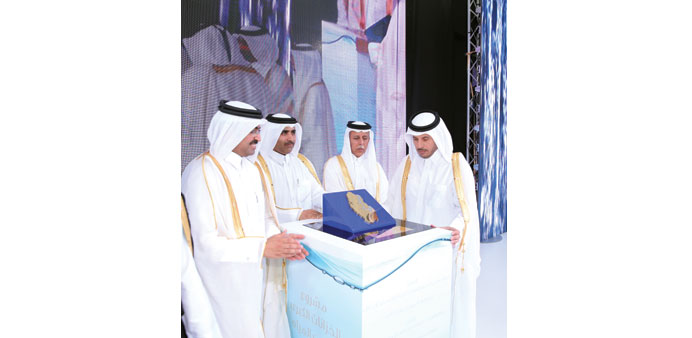HE the Prime Minister and Minister of Interior Sheikh Abdulla bin Nasser bin Khalifa al-Thani at the foundation laying ceremony at Al Mazrouah yesterday. The ceremony was attended among others by HE the Deputy Prime Minister Ahmed bin Abdulla bin Zayed al-Mahmoud, HE the Minister of Energy and Industry Dr Mohamed Saleh al-Sada, HE the Minister of Transport Jassem Seif bin Ahmed al-Sulaiti, HE the Minister of Environment Ahmed Amer Mohamed al-Humaidi, Kahramaa president Essa bin Hilal al-Kuwari and Ashghal president Nasser Ali al-Mawlawi.
The mega reservoirs are being built as part of a government plan to meet the growing requirements for potable water in the country
By Ramesh Mathew/Staff Reporter
The foundation stone of the QR17bn Mega Reservoirs Project was laid yesterday by HE the Prime Minister and Minister of Interior Sheikh Abdulla bin Nasser bin Khalifa al-Thani at Al Mazrouah, on the outskirts of Umm Salal Ali and about 40km from Doha.
The function was held at a site adjacent to where the excavation for the gigantic project commenced a little more than a year ago. The project site, spread over 1sq km, is about 12km off the truck route between Lusail and Salwa.
The reservoir in Al Marzouah is one of the five mega reservoirs to be set up in the country as part of the project, expected to be fully commissioned by the middle of 2018.
The works of other reservoirs will be taken up in coming months in Umm Birka, Rawdat al Rashed, Abu Nakhla and Al Thumama, HE the Minister of Energy and Industry Dr Mohamed Saleh al-Sada said.
The mega reservoirs are being built as part of a government plan to meet the growing requirements for potable water in the country which witnessed a huge growth in its population in the last one decade.
Potable or desalinated water for the country's residents is generated at locations in Ras Laffan and Ras Aboud.
The water, now delivered directly to 24 or so small reservoirs across the country, will be routed to the mega reservoirs when their construction is completed, three years from now.
As part of the latest development, more than 650km of water pipelines of approximately 900mm to 1600mm will be laid along the route, covering about 180km.
The design of the project is made in such a way that water will be delivered directly from the desalination plants to any of the new reservoirs. Construction allows water to be passed along the corridor in either direction, ensuring security and operational flexibility.
Qatar now has facilities to store more than 900mn gallons a day (mlgd). The five new reservoirs, when completed, will together have 24 storage tanks and they will ensure an additional storage capacity of nearly 2,273mlgd.
In terms of their size and capacity, the new reservoirs, each of which spread over 1sq km, are among the largest in the world, according to Kahramaa officials.
The new reservoirs are designed to channel the water back in transmission network to existing reservoirs for final distribution onto other reservoirs. Each of the storage tanks at the new reservoirs measures 150m by 300m and has 12m in depth. At present, the peak daily demand of potable water in the country exceeds 330mlgd.
The ceremony was attended among others by HE the Deputy Prime Minister and Minister of State for the Council of Ministerial Affairs Ahmed bin Abdulla bin Zayed al-Mahmoud, HE the Minister of Transport Jassem Seif bin Ahmed al-Sulaiti, HE the Minister of Environment Ahmed Amer Mohamed al-Humaidi, Kahramaa president Essa bin Hilal al-Kuwari and Ashghal president Nasser Ali al-Mawlawi.
As many as 17 companies are involved in the construction process and 55% of them are local.
60,000 truck loads of pipes needed for construction
The construction of the five major water reservoirs across the country would require no less than 60,000 truck loads of pipes, it was informed yesterday. The Qatar General Electricity and Water Corporation (Kahramaa) sources said the construction, which could spread over three years, would require more than 510,000 tonnes of pipes. The water stored in each of the new facilities at one time would be close to what is usually stored in more than 500 Olympic standard swimming pools.



